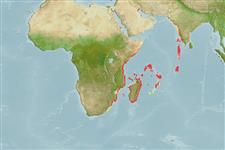>
Acropomatiformes (Oceanic basses) >
Pempheridae (Sweepers)
Etymology: Parapriacanthus: Greek, para = near + Greek, prion = saw + Greek, akantha = thorn (Ref. 45335); punctulatus: Name from Latin 'punctulatus' for dotted; referring to the profusion of dark dots on the side of the body below the lateral line that extend well posterior to the origin of the anal fin; these dots are more evident on preserved specimens than in life..
Environment: milieu / climate zone / depth range / distribution range
Ecologie
marien rifbewoner; diepte 16 - 61 m (Ref. 107896). Tropical
Verspreiding
Landen | FAO regio's | Ecosystemen | Voorkomen | Point map | Introducties | Faunafri
Western Indian Ocean: wide-ranging from South Africa (KwaZulu-Natal) and Mozambique to the Comoro Islands, northern Madagascar, Seychelles, the Mascarene Ridge, and the Mascarene Island of Réunion.
Grootte / Gewicht / Leeftijd
Maturity: Lm ? range ? - ? cm
Max length : 6.7 cm SL mannelijk / geslacht onbekend; (Ref. 107896); 5.0 cm SL (female)
Korte beschrijving
Determinatiesleutels | Morfologie | Morfometrie
Dorsale stekels (totaal) : 6; Dorsale zachte stralen (totaal) : 9; Anale stekels: 3; Anale zachte stralen: 20 - 23. This species is characterized by the following: D VI,9; A III,21 (20-23); pectoral-fin rays 16 (15-17); lateral-line scales 69 (63-72); scale rows above lateral line to base of dorsal fin 5.5; gill rakers 24 (23-26, modally 25); body depth 3.2 (3.25-3.35) in SL, width 2.1 (2.0-2.2) in body depth; depth of caudal-peduncle 10.4 (8.9-9.6) in SL; head length 2.95 (2.8-2.9) in SL; snout length 11.4-13.0 in SL; mouth forming an angle of about 60° to horizontal axis of body; sharply conical, recurved teeth in 2 irregular rows in upper row more forward-projecting, those of second row more strongly recurved; similar smaller teeth in lower jaw, well-spaced, in a single row; very small, incurved, sharply conical teeth in a single irregular row on vomer and palatines; thin lips, covered with closely adjacent papillae; tongue broadly triangular, indented indented on side near tip, forming a small, half-round, flexible flap; predorsal length 2.3 (2.3-2.4) in SL; first dorsal-fin soft ray is longest, 5.3 (4.7-5.4) in SL; caudal fin forked with fin length 4.5 (3.6-4.3) in SL; pectoral-fin length 3.5 (3.25-3.6) in SL; prepelvic length 2.7 (2.5-2.7) in SL; pelvic fins not reaching the anus, fin length 5.9 (5.1-6.5) in SL; preanal length 1.5 (1.5-1.6) in SL; without a pin-like dark line anterior to anus; instead a very dark blue band with a median dull pink streak that narrows anteriorly; black iris in preserved holotype (Ref. 107896).
Stomach contents include a half-digested polychaete about 45 mm by 5 mm, along with copepods, crustacean larvae, and small fishes (Ref. 107896).
Levenscyclus en paargedrag
Maturities | Voortplanting | Spawnings | Egg(s) | Fecundities | Larven
Randall, J.E. and S.V. Bogorodsky, 2016. Preliminary review of the pempherid fish genus Parapriacanthus of the western Indian Ocean, with descriptions of five new species. J. Ocean Sci. Found. 20:1-24. (Ref. 107896)
Status op de Rode Lijst van het IUCN (Ref. 130435)
Gevaar voor de mens
Harmless
Gebruik door de mens
Tools
Speciale rapporten
Download XML
Internetbronnen
Estimates based on models
Fylogenetische diversiteitsindex (Ref.
82804): PD
50 = 0.5005 [Uniqueness, from 0.5 = low to 2.0 = high].
Bayesian length-weight: a=0.01479 (0.00642 - 0.03409), b=3.02 (2.82 - 3.22), in cm total length, based on LWR estimates for this (Sub)family-body shape (Ref.
93245).
Trofisch niveau (Ref.
69278): 3.3 ±0.4 se; based on size and trophs of closest relatives
Weerstandsvermogen (Ref.
120179): Hoog, minimale populatieverdubbelingstijd minder dan 15 maanden (Preliminary K or Fecundity.).
Fishing Vulnerability (Ref.
59153): Low vulnerability (10 of 100).
